人教版(2019)选择性必修 第一册Unit 1 People of Achievement Using Language(2)-课件(共37张)
文档属性
| 名称 | 人教版(2019)选择性必修 第一册Unit 1 People of Achievement Using Language(2)-课件(共37张) |  | |
| 格式 | pptx | ||
| 文件大小 | 5.9MB | ||
| 资源类型 | 教案 | ||
| 版本资源 | 人教版(2019) | ||
| 科目 | 英语 | ||
| 更新时间 | 2025-03-04 14:22:56 | ||
图片预览


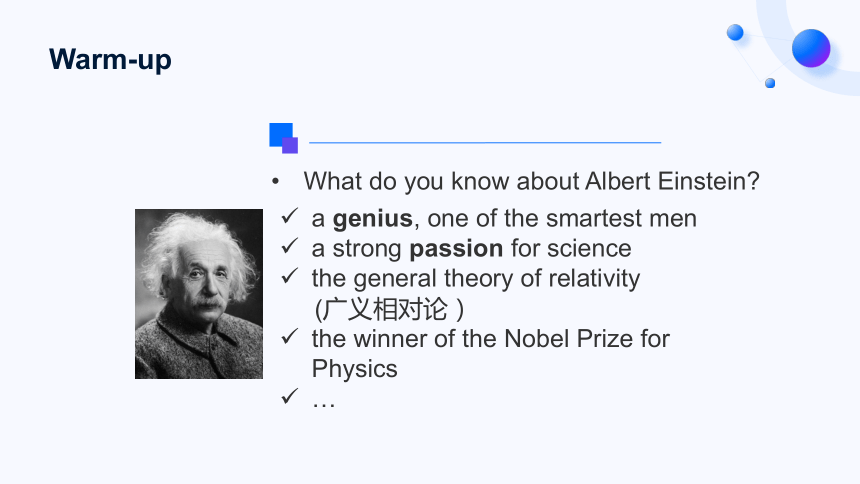

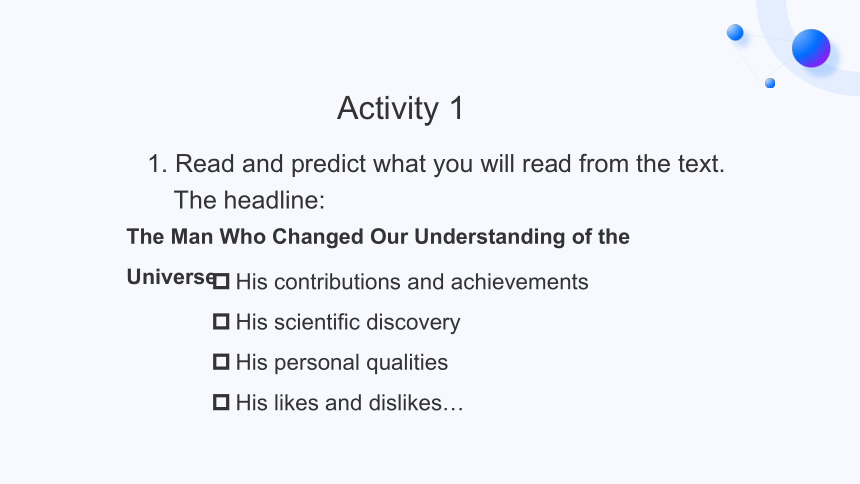
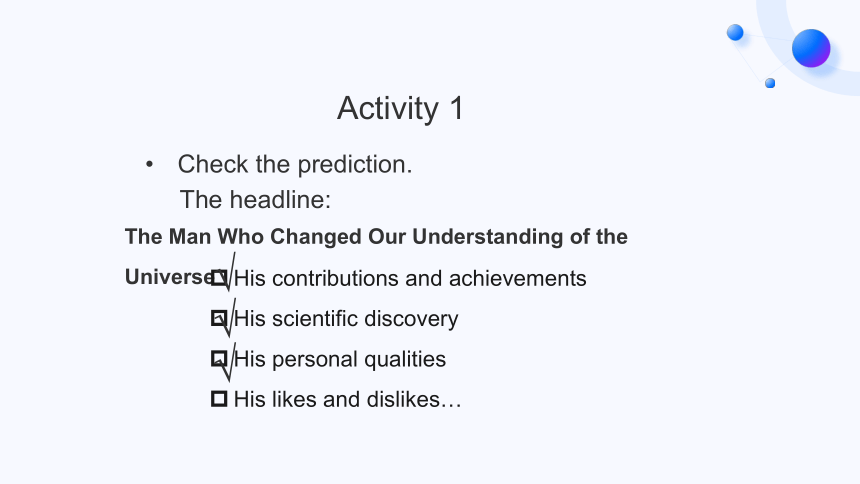
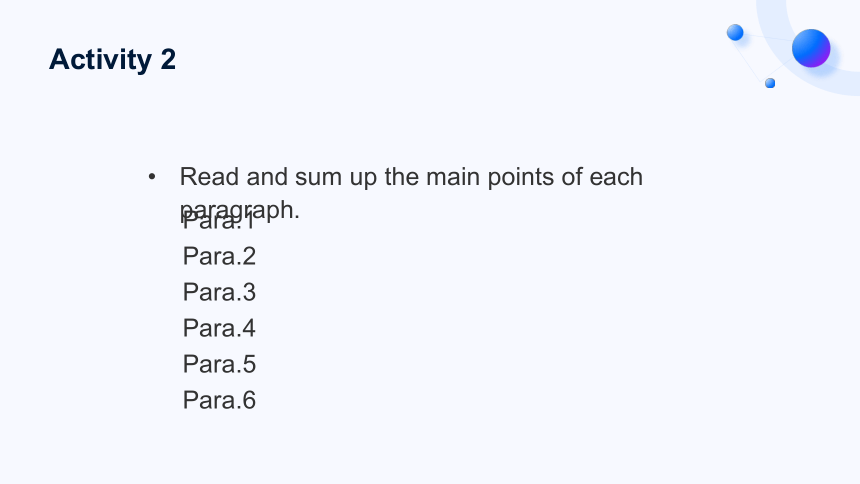
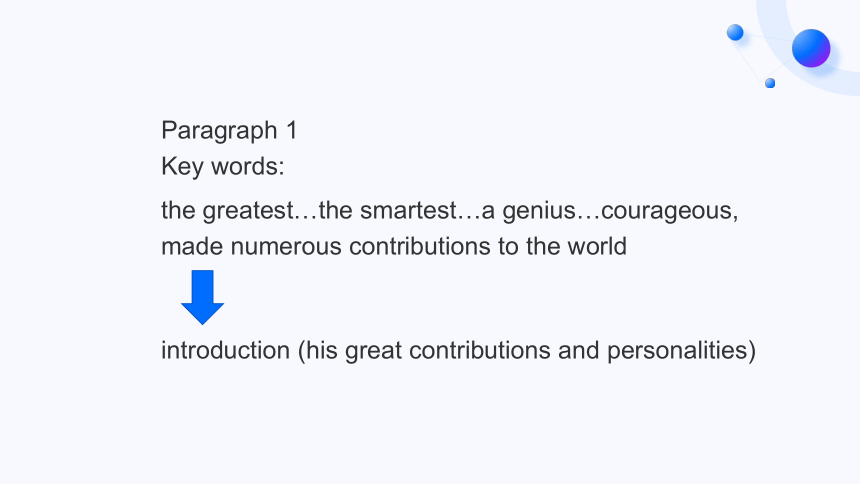
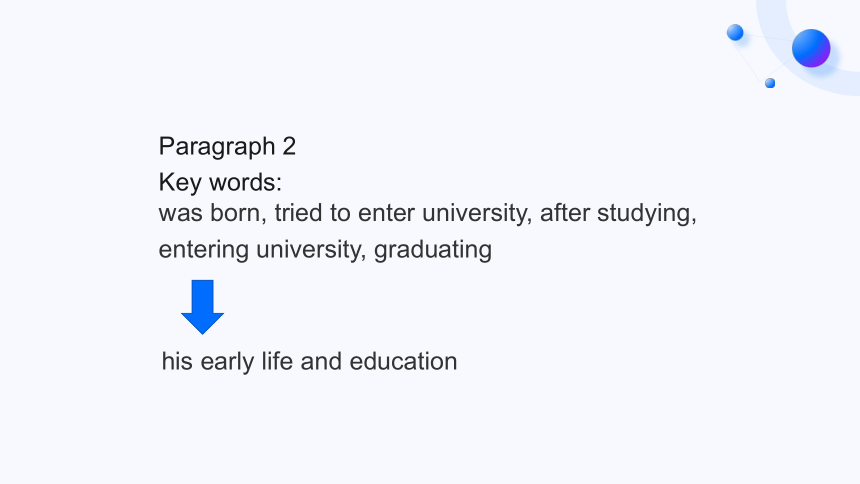
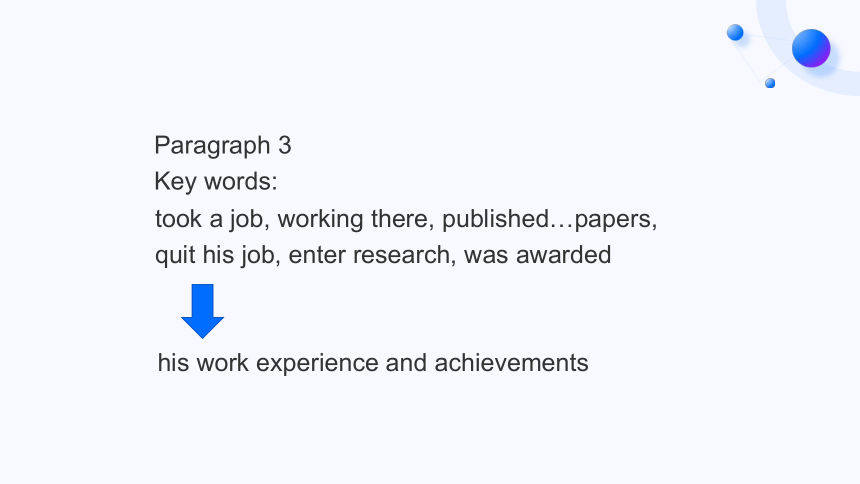


文档简介
(共37张PPT)
Unit 1 People of Achievement
Using Language(2)
In this class, you will
collect information about a great scientist through reading a biography;
study the organization and language features of the biography to improve your writing skills.
人物传记
Learning Objectives
What do you know about Albert Einstein
a genius, one of the smartest men
a strong passion for science
the general theory of relativity
(广义相对论)
the winner of the Nobel Prize for Physics
…
Warm-up
What words would you use to describe him
slightly odd-looking
clever, wise
well-known, famous
brilliant, intelligent
kind, gentle
outstanding, extraordinary
Warm-up
The Man Who Changed Our Understanding of the Universe
His contributions and achievements
His scientific discovery
His personal qualities
His likes and dislikes…
1. Read and predict what you will read from the text.
The headline:
Activity 1
The Man Who Changed Our Understanding of the Universe
His contributions and achievements
His scientific discovery
His personal qualities
His likes and dislikes…
Check the prediction.
The headline:
√
√
Activity 1
√
Read and sum up the main points of each paragraph.
Para.1
Para.2
Para.3
Para.4
Para.5
Para.6
Activity 2
Paragraph 1
Key words:
introduction (his great contributions and personalities)
the greatest…the smartest…a genius…courageous,
made numerous contributions to the world
his early life and education
was born, tried to enter university, after studying,
entering university, graduating
Paragraph 2
Key words:
took a job, working there, published…papers,
quit his job, enter research, was awarded
his work experience and achievements
Paragraph 3
Key words:
found the doors of academic institutions closed to
him, had to flee Germany
rhetorical device 修辞手法
metaphor 暗喻
his mid-life crisis
Paragraph 4
Key words:
Paragraph 5
Key words:
his appearance
a slightly odd-looking but kind and funny man, had a thick
moustache and long white hair, which sometimes
stood on end as though he had just received an electric shock
rhetorical device 修辞手法
personification 拟人
Paragraph 5
Key words:
a slightly odd-looking but kind and funny man, had a thick
moustache and long white hair, which sometimes
stood on end as though he had just received an electric shock
rhetorical device 修辞手法
simile 明喻
a slightly odd-looking but kind and funny man, had a thick
moustache and long white hair, which sometimes
stood on end as though he had just received an electric shock
rhetorical device 修辞手法
simile 明喻
rhetorical device 修辞手法
personification 拟人
Paragraph 5
Key words:
forgot things, helped a little girl, encountered people,
asked him to help explain things
stories showing his personalities
Paragraph 5
Key words:
mourned the great loss of a brilliant scientist
Einstein’s death
Paragraph 6
Key words:
On 18 April 1955, it was reported that Einstein
had passed away, and the whole world mourned
the great loss of a brilliant scientist.
rhetorical device 修辞手法
euphemism 委婉
Para.1 Introduction (great contributions and personal qualities)
Para.2 Early life/Education
Para.3 Work experience and achievements
Para.4 Mid-life crisis
Para.5 Appearance and stories showing personalities
Para.6 Death
Read and sum up the main points of each paragraph.
Activity 2
1. Read the text and complete the timeline.
Tips:
1. Look for the time and key words;
2. Use some math skills if needed.
Activity 3
in 1879 Was born in Germany
in ( )
in 1896
in ( )
in ( )
in ( )
in ( )
in ( )
in 1933
in 1955
Tried but failed to enter university in Switzerland
Entered university
Graduated from university
Took a job as a clerk in the Swiss patent office
Earned a doctorate in physics
Quit his job and entered research at a university
Was awarded the Nobel Prize
Had to flee Germany
Died in the United States
1895
1900
1902
1905
1909
1922
2. Introduce Einstein’s life story and achievements in
your own words.
when
after…doing for …years
after…years of…
that same year
following this, following that
finally
Activity 3
Think about the following questions.
1. Apart from his remarkable achievements,
what does the passage tell us about Einstein’s life
Struggles:
when he failed to pass his university exam
when he failed to get a good job
when he had to flee Germany
Activity 4
be friendly and easy to approach
deal with people in gentleness and good humor
Activity 4
Think about the following questions.
2. What impressed you most about Einstein’s life
State your reasons.
Study the organization and language features.
1. What type of writing is this text
How does the writer develop the text
The text is a biography.
It is developed in time order.
Activity 5
Metaphor (暗喻)
Personification(拟人)
Simile (明喻)
Euphemism(委婉)
the doors of academic institutions (Para.4)
as though…received an electric shock (Para.5)
(hair) stood on end (Para.5)
had passed away (Para.6)
Activity 5
Study the organization and language features.
2. What rhetorical devices are used in the passage
Write an introduction about someone you admire.
1. Choose the person you are going to write about.
2. Make a list of things that need to be included in
your introduction.
3. Use your notes to write your introduction and sum
up how you feel about this person.
Activity 6
Below are just two ways to write about someone we admire.
There could be two different models for a biography.
Focus on one of the great person’s important discoveries, like what we’ve read in the text about Tu Youyou
Focus on the great person’s life in general, like what we’ve read in the text about Albert Einstein
Summary
How to introduce someone you admire
Tips:
1. Before you start writing, gather information
and put it in order.
2. Ask yourself questions about the content,
the structure and the rhetorical devices.
Summary
How to show a person’s personalities
Tips:
1. Use adjectives to describe a person directly.
2. Use impressive stories.
How to make vivid description
Use rhetorical devices.
Simile (明喻)
Metaphor (暗喻)
Personification(拟人)
Euphemism(委婉)
…
Summary
1. Write an introduction about someone you admire.
2. Use the checklist on Page 9 to help you review
your own draft.
Homework
Unit 1 People of Achievement
Using Language(2)
In this class, you will
collect information about a great scientist through reading a biography;
study the organization and language features of the biography to improve your writing skills.
人物传记
Learning Objectives
What do you know about Albert Einstein
a genius, one of the smartest men
a strong passion for science
the general theory of relativity
(广义相对论)
the winner of the Nobel Prize for Physics
…
Warm-up
What words would you use to describe him
slightly odd-looking
clever, wise
well-known, famous
brilliant, intelligent
kind, gentle
outstanding, extraordinary
Warm-up
The Man Who Changed Our Understanding of the Universe
His contributions and achievements
His scientific discovery
His personal qualities
His likes and dislikes…
1. Read and predict what you will read from the text.
The headline:
Activity 1
The Man Who Changed Our Understanding of the Universe
His contributions and achievements
His scientific discovery
His personal qualities
His likes and dislikes…
Check the prediction.
The headline:
√
√
Activity 1
√
Read and sum up the main points of each paragraph.
Para.1
Para.2
Para.3
Para.4
Para.5
Para.6
Activity 2
Paragraph 1
Key words:
introduction (his great contributions and personalities)
the greatest…the smartest…a genius…courageous,
made numerous contributions to the world
his early life and education
was born, tried to enter university, after studying,
entering university, graduating
Paragraph 2
Key words:
took a job, working there, published…papers,
quit his job, enter research, was awarded
his work experience and achievements
Paragraph 3
Key words:
found the doors of academic institutions closed to
him, had to flee Germany
rhetorical device 修辞手法
metaphor 暗喻
his mid-life crisis
Paragraph 4
Key words:
Paragraph 5
Key words:
his appearance
a slightly odd-looking but kind and funny man, had a thick
moustache and long white hair, which sometimes
stood on end as though he had just received an electric shock
rhetorical device 修辞手法
personification 拟人
Paragraph 5
Key words:
a slightly odd-looking but kind and funny man, had a thick
moustache and long white hair, which sometimes
stood on end as though he had just received an electric shock
rhetorical device 修辞手法
simile 明喻
a slightly odd-looking but kind and funny man, had a thick
moustache and long white hair, which sometimes
stood on end as though he had just received an electric shock
rhetorical device 修辞手法
simile 明喻
rhetorical device 修辞手法
personification 拟人
Paragraph 5
Key words:
forgot things, helped a little girl, encountered people,
asked him to help explain things
stories showing his personalities
Paragraph 5
Key words:
mourned the great loss of a brilliant scientist
Einstein’s death
Paragraph 6
Key words:
On 18 April 1955, it was reported that Einstein
had passed away, and the whole world mourned
the great loss of a brilliant scientist.
rhetorical device 修辞手法
euphemism 委婉
Para.1 Introduction (great contributions and personal qualities)
Para.2 Early life/Education
Para.3 Work experience and achievements
Para.4 Mid-life crisis
Para.5 Appearance and stories showing personalities
Para.6 Death
Read and sum up the main points of each paragraph.
Activity 2
1. Read the text and complete the timeline.
Tips:
1. Look for the time and key words;
2. Use some math skills if needed.
Activity 3
in 1879 Was born in Germany
in ( )
in 1896
in ( )
in ( )
in ( )
in ( )
in ( )
in 1933
in 1955
Tried but failed to enter university in Switzerland
Entered university
Graduated from university
Took a job as a clerk in the Swiss patent office
Earned a doctorate in physics
Quit his job and entered research at a university
Was awarded the Nobel Prize
Had to flee Germany
Died in the United States
1895
1900
1902
1905
1909
1922
2. Introduce Einstein’s life story and achievements in
your own words.
when
after…doing for …years
after…years of…
that same year
following this, following that
finally
Activity 3
Think about the following questions.
1. Apart from his remarkable achievements,
what does the passage tell us about Einstein’s life
Struggles:
when he failed to pass his university exam
when he failed to get a good job
when he had to flee Germany
Activity 4
be friendly and easy to approach
deal with people in gentleness and good humor
Activity 4
Think about the following questions.
2. What impressed you most about Einstein’s life
State your reasons.
Study the organization and language features.
1. What type of writing is this text
How does the writer develop the text
The text is a biography.
It is developed in time order.
Activity 5
Metaphor (暗喻)
Personification(拟人)
Simile (明喻)
Euphemism(委婉)
the doors of academic institutions (Para.4)
as though…received an electric shock (Para.5)
(hair) stood on end (Para.5)
had passed away (Para.6)
Activity 5
Study the organization and language features.
2. What rhetorical devices are used in the passage
Write an introduction about someone you admire.
1. Choose the person you are going to write about.
2. Make a list of things that need to be included in
your introduction.
3. Use your notes to write your introduction and sum
up how you feel about this person.
Activity 6
Below are just two ways to write about someone we admire.
There could be two different models for a biography.
Focus on one of the great person’s important discoveries, like what we’ve read in the text about Tu Youyou
Focus on the great person’s life in general, like what we’ve read in the text about Albert Einstein
Summary
How to introduce someone you admire
Tips:
1. Before you start writing, gather information
and put it in order.
2. Ask yourself questions about the content,
the structure and the rhetorical devices.
Summary
How to show a person’s personalities
Tips:
1. Use adjectives to describe a person directly.
2. Use impressive stories.
How to make vivid description
Use rhetorical devices.
Simile (明喻)
Metaphor (暗喻)
Personification(拟人)
Euphemism(委婉)
…
Summary
1. Write an introduction about someone you admire.
2. Use the checklist on Page 9 to help you review
your own draft.
Homework
